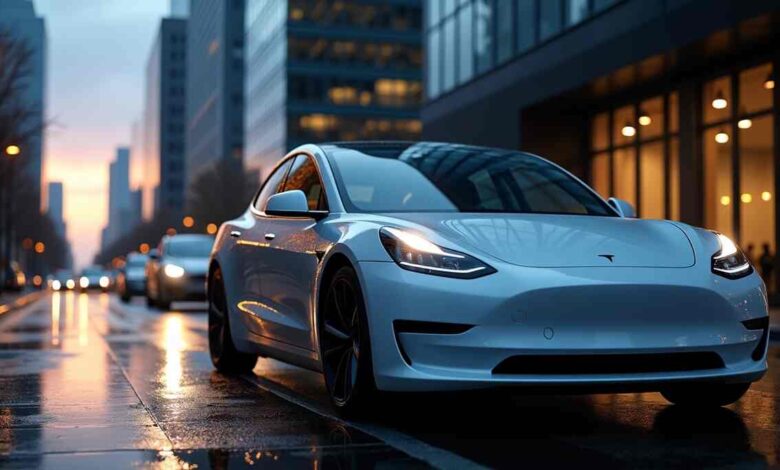Tesla Auto Insurance: The Hidden Costs Most Drivers Don’t Know About
Tesla Auto Insurance:

Tesla Auto Insurance: Tesla’s innovative electric vehicles are well-known, but their auto insurance program might not save drivers as much money as expected. The company advertises rates 20-30% lower than traditional insurers, yet our research shows the surprising hidden costs that could substantially affect your wallet.
My experience as a Tesla owner taught me that their auto insurance works differently than it appears. The program comes with variable monthly premiums tied to safety scores, limited repair options, and unexpected surcharges. These factors matter more than just the quoted rate. Current and prospective Tesla drivers should understand these hidden costs before making their insurance choice.
Understanding Tesla Insurance Basics
Let me show you how Tesla Auto Insurance: works and why it’s different from traditional auto insurance. The sort of thing I love about Tesla’s approach to car insurance is their unique way of setting your premium.
How Tesla’s insurance model is different from traditional insurance
Traditional insurers can’t match Tesla Insurance’s use of real-time driving data to calculate monthly premiums. They don’t look at factors like age, gender, or credit history to set rates. Your actual driving behavior and vehicle usage determine your rates.
Tesla Insurance makes tracking your driving habits simple – everything comes built into the vehicle. New customers start with a Safety Score of 90. Your premium changes monthly based on how well you drive and your mileage.
States where Tesla Insurance is available
Tesla Insurance currently serves 12 states:
- Arizona
- California
- Colorado
- Illinois
- Maryland
- Minnesota
- Nevada
- Ohio
- Oregon
- Texas
- Utah
- Virginia
California works differently than other states and doesn’t use the live insurance model to set premiums.
Coverage options and limitations
Tesla’s coverage options are quite flexible. You can customize full coverage options with various limits and deductibles that match your needs. On top of that, several key factors affect your premium:
- Your vehicle’s Safety Score
- Miles driven
- Where you live
- Vehicle make and model
- Coverage selected
- Number of vehicles insured
You can save money with a multi-car discount by insuring multiple vehicles under one policy. The Tesla app helps you manage your policy, track your Safety Score, and submit claims.
The Safety Score feature only works with Tesla vehicles, even though Tesla Insurance covers non-Tesla vehicles in some states. More than that, Tesla vehicles that don’t transmit data for 60 straight days become unconnected vehicles, which might change your premium calculations.
The Real Cost of Tesla Insurance
Let me share what I’ve learned about Tesla auto insurance costs from my research and experience. The insurance costs for Teslas are much higher than regular vehicles, and there are some interesting differences between models.
Average premium comparison by model
Here’s what you can expect to pay annually for different Tesla models:
| Tesla Model | Annual Premium | Monthly Average |
|---|---|---|
| [Model 3 | $2,221](https://www.nerdwallet.com/article/insurance/tesla-insurance) | $185 |
| Model Y | $2,438 | $203 |
| Model S | $3,215 | $268 |
| Model X | $3,831 | $319 |
These numbers really stand out when you match them against a Toyota Camry’s insurance cost, which runs about $2,296 per year.
Factors affecting Tesla insurance rates
My research shows several elements that shape your Tesla insurance premium:
- Vehicle value and repair costs
- Safety Score (starting at 90 for new policies)
- Monthly mileage
- Garaging location
- Number of vehicles insured
Repair costs play a big role in these higher premiums. Tesla repairs cost $5,552 on average [link_2], which is much more than other EVs at $4,474.
Hidden fees and surcharges
Something that really grabbed my attention was the unexpected costs that many drivers don’t see coming. Insurance premiums can change quickly without warning. Some Tesla owners have seen their monthly premiums jump from $130 to $250.
Here are some hidden costs I’ve found:
- Premium Adjustments: Your rates might change right away with policy updates, monthly based on mileage and Safety Score changes, or during renewal from rate adjustments.
- Repair Limitations: You must fix your Tesla at Tesla-approved body shops, which often means higher costs because options are limited.
- Parts Replacement: Tesla’s design uses fewer, larger body pieces, so even small damage might need bigger section replacements.
- State-Specific Variations: Location makes a big difference in insurance costs. Tesla owners in California saw their rates go up by a lot in July 2024 because of state policy changes.
Safety Score System Explained
I’ve been looking into Tesla’s insurance costs, and the sort of thing I love is their Safety Score system that determines your monthly premiums. This scoring approach has definitely changed my perspective on auto insurance.
How Tesla calculates your safety score
The Safety Score Beta system looks at five metrics to evaluate your driving behavior:
- Forward Collision Warnings per 1,000 miles
- Hard Braking (speed decrease > 6.7 mph in one second)
- Aggressive Turning (speed increase > 8.9 mph in one second)
- Unsafe Following (at speeds over 50 mph)
- Forced Autopilot Disengagement
Tesla combines these factors into a score between 0 and 100. Most drivers should achieve 80 or above. Miles driven with Autopilot don’t affect your score, though they count toward total mileage calculations.
Effect on monthly premiums
These scores can drastically change insurance costs. Here’s a real example of monthly premium variations:
| Safety Score | Monthly Premium |
|---|---|
| 90 | $121 |
| 98 | $83 |
Tesla estimates that average drivers save between 20% to 40% compared to other insurance providers. Drivers with excellent scores can save 30% to 60%.
Common problems affecting scores
My research reveals several challenges Tesla owners face:
- System Limitations:
- False Forward Collision Warnings hurt scores
- Phantom braking incidents affect Hard Braking metrics
- Safe following distance guidelines lack clarity
- Environmental Factors:
- Night driving penalties between 10 PM and 4 AM
- Urban driving makes maintaining safe following distance tough
- Weather conditions affect braking and turning scores
The system doesn’t count driving data during the first three seconds after disengaging Autopilot. This grace period helps avoid unfair penalties during manual takeover.
Your score can improve if you:
- Keep several car lengths of following distance
- Use regenerative braking whenever possible
- Slow down before entering turns
- Plan trips outside late-night hours
- Use Autopilot during heavy traffic
Tesla knows the system isn’t perfect. They label it as “Beta” and make adjustments based on data collected from over 9.6 billion kilometers of fleet data.
Claims Process Challenges
My experience handling many Tesla insurance claims shows the process isn’t as smooth as people think. Here’s what I learned about the challenges you might face when filing a claim.
Average claim processing times
The timeline for Tesla insurance claims can drag on longer than expected. Recent data shows some customers waited up to seven months for claim resolution. The processing times vary widely:
| Claim Type | Average Processing Time |
|---|---|
| Minor Damage | 30-45 days |
| Major Accidents | 4-6 months |
| Total Loss | 7+ months |
These long timelines stem from Tesla Insurance’s understaffing issues. Their adjusters handle hundreds of claims each – nowhere near the workload at traditional insurance companies.
Common customer complaints
My research shows several recurring problems that Tesla insurance customers face:
- Unresponsive adjusters: Customers spend hours on hold and get disconnected multiple times
- Communication gaps: Policyholders wait weeks or months with no claim updates
- Staffing problems: The original team of adjusters in California couldn’t handle the case volume
- Parts delays: Parts availability issues slow down claim processing
A troubling case involved a policyholder who waited seven months to get paid for a totaled vehicle and still hasn’t received $50,000 in medical expenses.
Tips for expediting claims
Based on claims that worked out well, here are proven ways to speed up your Tesla insurance claim:
- Documentation Excellence
- Take detailed photos and videos right after the incident
- Get witness contact information quickly
- Keep records of all communication attempts
- Strategic Communication
- File your claim within 24 hours
- Use the Tesla app to file your initial claim
- Add your claim number with dashes in all email subject lines
- Follow-up Protocol
- Stay in touch with your assigned adjuster
- Document all communication attempts
- File a complaint with your state’s insurance department if delays go beyond legal timelines
Without doubt, persistent and documented communication works best. You can ask state insurance regulators to intervene if you don’t get responses quickly enough.
Using a Tesla-authorized repair center usually makes processing smoother. Note that parts availability and repair center capacity can still affect your timeline a lot.
Repair and Maintenance Costs
My deep dive into Tesla’s repair and maintenance structure revealed some startling facts about costs that affect insurance rates. Let me walk you through everything I found about keeping these cutting-edge vehicles on the road.
Tesla-approved repair center limitations
Tesla keeps tight control over their repair network through Tesla Approved Collision Centers (TACC). These centers must meet several strict requirements:
- Factory-trained technicians with specialized certifications
- Approved equipment and tooling for Tesla repairs
- Direct connection to Tesla engineering support
- Adherence to Tesla’s repair procedures and guidelines
- Knowing how to order restricted parts
Your warranty could become void if repairs happen outside approved centers. This limited network of repair facilities results in longer wait times and repairs that can get pricey.
Replacement part expenses
Tesla parts and repairs cost much more than standard vehicles. Here’s what you might pay for common repairs:
| Repair Type | Average Cost |
|---|---|
| MCU Replacement | $2,700 |
| Battery Replacement | $13,000-$20,000 |
| Door Handle Repair | $200-$1,000 |
| Tire Replacement | $195-$450 per tire |
Tesla’s design philosophy makes even small repairs expensive. A basic plastic bumper runs $500, and the total repair bill could hit $7,000-$12,000. This happens because Tesla’s larger body pieces usually need complete replacement instead of spot repairs.
Impact on insurance premiums
Repair costs directly drive insurance premiums – higher repair costs mean bigger premiums. The maintenance data tells an interesting story:
- Annual maintenance costs range from $587 to $832
- The average Tesla repair cost sits at $5,552
- Insurance companies often write off vehicles when repair costs climb too high
Tesla’s insurance stands out because of their feedback loop system. They use repair cost data to adjust design and software changes that help reduce repair expenses. All Tesla owners benefit from this approach through:
- Design modifications to minimize repair costs
- Software updates to prevent accidents
- Improved parts availability through authorized channels
Tesla vehicles need less regular maintenance than conventional cars. In spite of that, repairs cost more than typical luxury vehicles. A Honda’s annual maintenance runs $428 and Toyota’s is $441, while Tesla averages $832.
Tesla’s sophisticated electronics and specialized parts turn minor collisions into major insurance claims. A recent Model Y in a front collision with a retail price of $61,388 needed $50,388 in repairs. Another Model Y with side damage priced at $72,667 required $43,814 in repairs.
Alternative Insurance Options
Let me share what I found about other insurance options that might work better for you, now that we’ve looked at Tesla’s own insurance program. My research of insurance providers revealed some great alternatives worth thinking about.
Traditional insurance companies covering Teslas
Several major insurers have created specialized coverage for Tesla vehicles. State Farm, a 100-year old company known for its vast network and stability, offers detailed Tesla coverage with special features for electric vehicles. Travelers has become a game-changer by offering some of the best rates I’ve seen for Tesla Model 3 owners.
GEICO makes an interesting case – they cover all 50 states, while Tesla Insurance only operates in 12 states. These traditional insurers give you:
- Specialized EV coverage and discounts
- Nationwide availability
- Strong claims processing systems
- Multiple policy bundling options
Cost comparison with Tesla Insurance
My analysis of current rates shows how different providers match up:
| Insurance Provider | Monthly Rate |
|---|---|
| Tesla Insurance | $169 |
| State Farm | <citation index=”5″ link=”https://www.valuepenguin.com/tesla-car-insurance” similar_text=”### Average full coverage car insurance quotes for Teslas Company Monthly rate Tesla Insurance |
| USAA | <citation index=”5″ link=”https://www.valuepenguin.com/tesla-car-insurance” similar_text=”### Average full coverage car insurance quotes for Teslas Company Monthly rate Tesla Insurance |
| Nationwide | <citation index=”5″ link=”https://www.valuepenguin.com/tesla-car-insurance” similar_text=”### Average full coverage car insurance quotes for Teslas Company Monthly rate Tesla Insurance |
| Progressive | <citation index=”5″ link=”https://www.valuepenguin.com/tesla-car-insurance” similar_text=”### Average full coverage car insurance quotes for Teslas Company Monthly rate Tesla Insurance |
Rates change by a lot depending on your state. California drivers pay an average of $187 monthly for Tesla Insurance, while GEICO charges $268, and State Farm costs $320.
Pros and cons of different providers
Each insurance option brings its own benefits and drawbacks. Here’s what I learned about each one:
Tesla Insurance Pros:
- Easy sign-up through Tesla app
- Immediate premium adjustments based on driving
- Combines smoothly with Tesla’s ecosystem
Cons:
- Available in only 12 states
- Higher complaint index (2.78 vs industry average 1.00)
- Limited live agent support
Traditional Insurers Pros:
- Strong customer service infrastructure
- Multiple coverage options and bundling
- Proven financial stability
Cons:
- Might not fully understand Tesla-specific features
- Need separate tracking devices for usage-based programs
- Higher base rates for Tesla vehicles usually
Some specialized programs caught my eye. Lemonade offers unique EV-specific benefits:
- Emergency charging coverage
- Wall charger protection
- Portable charger coverage
Whatever provider you pick, usage-based insurance programs are a great way to get substantial savings. To name just one example, Travelers’ IntelliDrive program can save you between 22% and 40% for safe driving.
Your choice depends on several factors. You’ll need to look at traditional insurers if you don’t live in one of Tesla’s covered states. My analysis suggests getting quotes from at least three providers – rates can change dramatically based on your situation and location.
Root Insurance gives you another option with their strictly telematics-based approach that works like Tesla’s model. They ask for a test drive period before offering coverage. This could work well if you trust your driving habits.
Conclusion
Tesla insurance brings a fresh take with its up-to-the-minute pricing model. My research shows it might not be the game-changer many people expect. Safety scores can help you save money, but repair limitations, expensive parts, and slow claims processing add hidden costs.
My findings suggest Tesla owners need to look at all their choices. Many traditional insurance companies match or offer better rates than Tesla while providing smoother claims support and bigger coverage networks. Your location, driving style, and how comfortable you feel with changing monthly premiums will shape your final choice.
The advertised rates don’t tell the whole story when picking insurance. You should look at how easy it is to find repair shops, get parts, and the company’s history of handling claims. Tesla insurance works great for some people, especially those who keep high safety scores. But other providers might give you better value based on your situation.
Without doubt, Tesla will improve their insurance program as they fix these issues. For now, my advice is to get quotes from different companies and take a good look at what each policy covers before you decide.
FAQs
Q1. Is Tesla insurance cheaper than other providers? Tesla insurance can be cheaper initially, with rates up to 20-30% lower than traditional insurers. However, the real-time pricing model based on driving behavior can lead to fluctuating premiums, potentially increasing costs over time for some drivers.
Q2. How does Tesla’s Safety Score system work? Tesla’s Safety Score system assesses driving behavior using metrics like forward collision warnings, hard braking, aggressive turning, and unsafe following. Scores range from 0 to 100, with most drivers expected to achieve 80 or above. Higher scores can lead to lower premiums, while lower scores may increase rates.
Q3. What are the main drawbacks of Tesla insurance? Common drawbacks include difficulty reaching customer service, long claim processing times, limited repair options, and the stress of constantly monitoring driving behavior to maintain a good safety score. Some drivers find this detracts from the enjoyment of driving their Tesla.
Q4. Is Tesla insurance available in all states? No, Tesla insurance is currently available in only 12 states: Arizona, California, Colorado, Illinois, Maryland, Minnesota, Nevada, Ohio, Oregon, Texas, Utah, and Virginia. Availability and features may vary by state.
Q5. How does Tesla handle insurance claims? Tesla’s claims process can be challenging, with some customers reporting long wait times, unresponsive adjusters, and difficulty reaching human representatives. However, keeping repairs within the Tesla ecosystem can sometimes lead to faster processing times and access to discounted parts.
Read more: Local Insurance Agents



